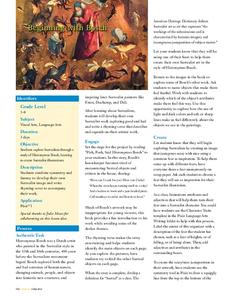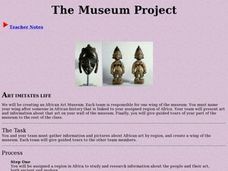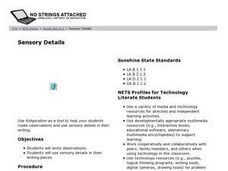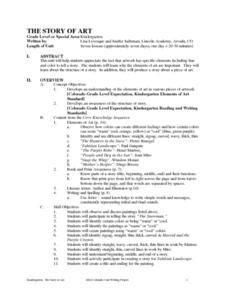Curated OER
Rain Forest Research
Second graders explore the Rain Forest. In this research lesson, 2nd graders go online to gather information about Rain Forest animals. Students print and use the information to write about the many parts of the Rain Forest. Students are...
Curated OER
Explore Chapters 1 - 5
Learners preview the novel, "Dragonwings," by Laurence Yep, make connections between the novel previewed and their prior knowledge, other texts, and the world. They utilize graphic representations including charts, graphs, pictures, and...
Curated OER
Letter Booklets: Qq to Zz
In these recognizing letters of the alphabet worksheets, students identify each letter Qq to Zz, and create booklets of each letter, trace and write the upper case and lower case letters, observe pictures of words with the beginning...
Curated OER
Literacy Activity: The Perfect Pet
Learners develop their listening skills as they listen to the book The Perfect Pet. In this reading lesson plan, students listen to the book, and then talk about the pets they have. Then they make a graph as a class of all their pets.
Curated OER
Beginning with Bosch
Students become familiar with surrealism through the artwork of Hieronymus Bosch. In this Bosch lesson plan, students explore symmetry and surrealism. Students create step by drawings on the computer in the style of Hieronymus Bosch....
Curated OER
Native Plant Research Project
Students study indigenous plants. They examine why they are special, why some might be threatened, by what forces (pollution, habitat destruction), and what else relies on the continued existence of these plants (insects, animals). They...
Curated OER
Adopt-An-Element
In this chemistry worksheet, learners complete an adopt an element information sheet. Then they create an advertisement for their element including the information listed. Students also write its important uses, interesting facts, and...
Curated OER
No Bones About It
Students act as paleontologists, examining pictures of dinosaur skeletons and applying their knowledge of the relationship between skeletal features and survival, to create 'Paleontology Reports' about their perceptions of the lives of...
Curated OER
The Museum Project
Students create an African Art Museum. Each group present art and information about that art on your wall of the museum.
Curated OER
Do You Haiku? We Do!
Third graders try their hands at writing Haiku, a form of Japanese poetry. Haiku is usually 17 syllables in three-line form. This engaging lesson has many excellent worksheets and website imbedded in the plan. They share their finished...
Curated OER
How Do Artists Get Their Ideas? Culture and Environment as Sources of Ideas
Students share the difficulties they have in determining what to write or draw for a project. In groups, they view examples from three different artists and discuss how their personal experiences affected their art. They brainstorm a...
Curated OER
We Like to Imagine - Animals
Students describe a pretend animal. They read "The After School Monster." Students read other books and discuss whether or not the characters are real. Students make a drawing of a pretend animal and of a real animal. They make up a...
Curated OER
Elements of Art iMovie
Students are introduced to how to use the iMovie software. Individually, they write down their personal beliefs and feelings to use in their movie. To end the lesson, they use the elements of design to develop and create their movie to...
Curated OER
The Torah Tells...
Young scholars extract and interpret information about the Torah text to draw conclusions about ancient Hebrew life. In this Torah lesson plan students research facts and complete worksheets about the Torah. Then as a class the young...
Curated OER
Make Something Beautiful
Students create an art piece using recycled objects. In this environmental activity, students collect and sort recycled objects and create a three dimensional art piece.
Curated OER
Transforming Negatives to Positives
Students write diamonte poems that correspond to the double-exposed photograph they created. In this poetry and multimedia artwork instructional activity, students use the photographic process to create a double-exposed...
Curated OER
Seed Surprises
Students investigate seeds and their growth. In this agriculture instructional activity, students read the book How a Seed Grows and discuss the seed cycle. Students examine real seeds and identify their properties. Students create a set...
Curated OER
Sensory Details
Students observe their environment and write detailed, sensory-specific sentences about that environment. This lesson can be extended to include the creation of a personalized story or movie of the experience (student examples are...
Curated OER
Spying on Spiders
Students investigate spiders. In this spiders lesson, students create a habitat for a spider with a jar, twigs, and dirt. Students observe the behavior of the spider and record how they spend their days.
Curated OER
Why Do Art?
Students examine the purposes of art and view examples of art created by artists, designers, and craftspeople. They write a report describing the various purposes for creating works of art.
Curated OER
In Our Own Voice
Learners, after being introduced to poetry in the language arts class, prepare to produce a product by identifying and writing a variety of different types of poetry. They utilize digital cameras, camcorders, computers and the multimedia...
Curated OER
Bestiarity and Gargoyles
Students complete an art project. For this gargoyles lesson, students learn about gargoyles and other medieval architecture features and discuss their purposes. Students create their own monsters using an etching technique. This lesson...
Curated OER
The Grandparent/Elder Project
Students interview a grandparent/elder to as part of a history and writing project. In this grandparent/elder project lesson, students record an interview of an older person who is willing to share their past. They look at pictures and...
Curated OER
The Story of Art
Students canvass the important elements of art in the seven lessons of this unit. Story structure and in particular, color is perceived as essential to the development of the idea of a picture.























